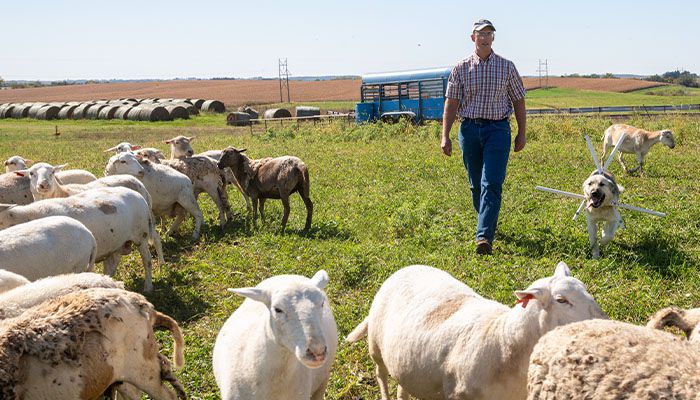Cover crops provide an economical benefit
Author
Published
10/20/2025
Farm experience, ISU research align on long-term value of planting cover crops.
Fayette County Farm Bureau member Damien Matt has had several moments of clarity since deciding to implement cover crops on his rural Castalia farming operation in northeast Iowa.
Environmentally, the decision has clearly been a positive move.
“We’ve had some torrential rainfalls where you can see the ruts in the fields … where they’re losing their topsoil,” explained Matt. “But it seems like in the cover crop fields, it holds together much better and you don’t see that. So the soil health benefits, building organic matter and holding the water is evident.”
Then there’s the economic benefit. His decision to rotate traditional cash crops with cover crop mixes every other year may seem risky to some, but for Matt’s operation, it has paid off.
“When corn was $7 a bushel … yeah, we missed out on some high-dollar grain sales,” he said. “But we’ve made money every year, and looking at my spreadsheets, we’re still making money at today’s prices. It really comes down to diversification … finding a way to maintain some profitability during more challenging economic times.”
For Matt, that means seeding cover crops for grazing his 250-head cow-calf herd, saving on feed costs, and planting nitrogen-fixing cover crops such as clover, hairy vetch, field peas or sunn hemp that will add nitrogen to the soil.
Financially, it makes sense on his farm.
“That next year when we rotate back to corn, we’re only putting 120 units of nitrogen with planting,” he said. “And that’s the only nitrogen application we do … so savings there. And we’ve got feed for the herd.”
Making economic sense
Matt’s approach is a good one, says Mark Licht, Iowa State University (ISU) associate professor and Extension cropping systems specialist. Diversification increases crop benefits, he said, and helps offset potential yield hits when seeding cover crops ahead of corn.
“On the soybean side, especially when we have cost share that can help with costs of seeding … it can be economically viable,” Licht said. “As far as a cover crop ahead of corn, we’re still seeing a yield penalty of from 5-25 bushels per acre. So we do have to be careful of that … There are some things that we can do to minimize that yield impact, but we’re still doing research on what’s causing it and how to reduce it.
“(Matt’s) is a very good system as far as trying to make it economically work. He’s getting the forage value … That’s a really good way to have cover crops out there.”
Ongoing ISU research trials focus on nitrogen dynamics and disease interactions, above-ground vs. root biomass and proximity to corn and soybean plants, how much cereal rye may be needed to control resistant waterhemp, and the potential for sulfur applications following cereal rye — all with the goal of mitigating any yield hit when implementing cover crops.
“We’re really trying to learn … some of that basic science that we then can start pulling things out to look into from a more applied perspective,” Licht said.
He added that there can be economic benefits to complement the obvious conservation benefits of seeding cover crops.
“There are many benefits … keeping nutrients in place as long as we can, … reducing that wind erosion through the winter months, … protecting the soil surface from rain and water runoff,” he said. “Those are tangible benefits that we can see.”

PICTURED ABOVE: Cover crops provide ample feed for Damien Matt’s cattle and sheep, which makes economical sense. Iowa State University researchers say diversification increases benefits such as providing forage for livestock. PHOTO / CONRAD SCHMIDT
Nontraditional approach
It’s been roughly 10 years since Matt’s father, Rick, first introduced cereal rye to the now fourth-generation farm. The plan was to build soil health and mitigate erosion while also providing feed for livestock, which now includes a 300-head sheep herd.
Matt calls his a nontraditional cover crop management system.
They plant cereal rye mixes in the fall that overwinter, complemented by a summer mix that includes sorghum sudangrass, forage peas, sunflowers, buckwheat, flax, radishes, rapeseed, Ethiopian cabbage, pearl millet, and red clover, among others, for animal feed and grazing.
“You’re able to turn them out on a green cover in early April and not have to worry about feeding those cows again,” he explained. “That’s pretty cool.”
He encourages other farmers to experiment, noting that benefits exist for every operation.
“You don’t have to try it on all your acres at once,” he said. “Pick a field and see how it suits your operation. Just because what I’m doing works well for my operation doesn’t mean it’s going to work well for the next guy’s. There’s context within each operation.”
Future considerations for Matt include a three-year rotation by adding a small grain like oats or wheat to the mix, hoping to gain additional diversity and profitability.
“I’m definitely not an expert on this … I trust that I am still learning with it every day,” he said.
Licht noted there are federal and state cost-share incentives for conservation measures like cover crop implementation. He suggests visiting costsharecompare.com, linked from the cost-share hub on the Iowa Agriculture Water Alliance website, to learn more about incentives.
Like Matt, Licht encourages starting small.
“It’s a complex change to the cropping system, so start small, even if it’s 20 acres, just to get a feel for what’s happening and what you need to do,” Licht said. “I always tell someone who is brand new, has never done cover crops before and maybe has the worry about yield penalties, start with a cover crop ahead of soybeans. It’s just a lot easier management.”

PICTURED ABOVE: Licht
Want more news on this topic? Farm Bureau members may subscribe for a free email news service, featuring the farm and rural topics that interest them most!